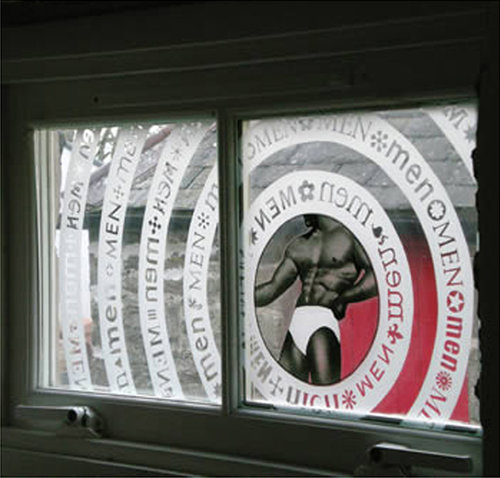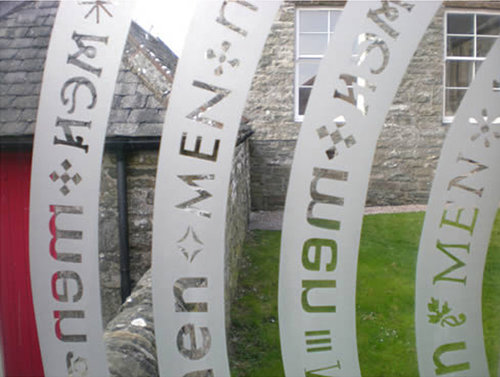by Joseph Cavalieri
Have you ever considered applying for an art residency? This type of opportunity can be a great experience – or not.

Window by Joseph Cavalieri/Residency Project
The Residency Dance
Within the last two years, I’ve had three residencies in Australia, India and Scotland. Each arrangement was different and resulted in different outcomes. I’d like to share what I have learned artist-to-artist of how to make an art residency work best for you. If done the right way they can be inspiring, productive and a great boost for your career. If the wrong choices are made they make you feel secluded and empty your pockets of cash.
HISTORY
Residencies originated as organizations that supported artists one hundred percent. They gave room, board, living expenses, and introductions, among other perks. Often the host was a private or non-profit organization, and received grants for supporting art. In return for their “support of the arts”, they improved the local community, added to their collection, and create a long-lasting relationship.
The term “residency” has changed over time. Now each are extremely different and offer varied arrangements. Some you may need to pay for the accommodations, travel and bring your own supplies. Read the fine print before spending the time on the application.
RESEARCH
Before you even start to research residencies, you should have answers to some very big questions about your work. What you are searching for as an artist, how you define success. These come under what we call a “vision statement.” It is the basic reasoning behind why you do your art. If a residency is in your vision statement, list what you want to get out of it before starting your search.
My “vision statement” includes teaching, inspiring other artists, and traveling. These are not first on the list, but they are an important element of my vision of being an artist. You may want a residency to be inspired by new surroundings and people, or a retreat to quietly continue your current work, or even to make contacts for future shows. Be honest and clear with what you want.
Think about if you can survive financially and mentally away from your studio for a month or two. Time spent at a residency can result in you producing less work. It takes time to adjust and set up a new work space in a new environment. You may need to bring supplies or figure out how to buy them in a foreign country. These are all things you need to consider before applying. Remember, residencies should not be considered vacations. They are hard work, with a high level of socializing thrown in.
THE SEARCH
With the “vision statement” in hand you can now start your search. To save time, I have a list of residency deadlines listed by month, so if I am not accepted this year, I know when to apply next year. Apply about a month in advance, so you are showing recent work, but not working the night before. My top three websites for searching for residencies include Wooloo, Café, and TransArtists.
A shortcut to searching for residencies is to read CV’s of fellow artists in your field. Here you will find residencies they did in the past. You can also contact them for questions and advice.
Once you find a potential residency opportuity, search the site for an application form. If this does not exist, send them a short email asking for the “guidelines for submitting an art-in-residency proposal.” No need to tell them about you or your work. Remember most of these organizations are non-profit and the staff has limited time.
IF A RESIDENCY IS NOT OFFERED
If you can’t take a full month off, or if an organization does not offer a residency, you have options. A local college may be open to having you stop by as a visiting artist, even if they don’t have a formal residency program. Once you find the correct contact person, send a clearly written proposal. Include the project, supplies, timing, and how you want to be reimbursed. Be creative; they may be much more open for a two day visit instead of two months.
SUBMISSIONS
Follow all steps as exactly as possible, and write your ideas out as clearly as possible. If this is not done, they will trash the application. When asked for images of your work, I prefer to send a couple of close-up shots to show details. Consider how your work is best understood. To show scale and context, you can show one photo including a frame, or two pieces hung side by side.
I highly recommend incorporating community interaction into your project. Think about the host, having different artists come and go every year. If you have a connection with local people, it keeps a bond between them and the host, which is something the host may want. Be creative with the proposals you are offering them. Write as clearly as possible; remember, they are reading huge numbers of applications.

Window Detail – Joseph Cavalieri/Residency Project
PAPERWORK
Once you are accepted, you need to do research and make as many contacts as possible before you physically arrive, so when you do arrive, you will have a group of people to work with, socialize with and (most importantly) get information from. Ask for any contacts your host has. Do a Google search or find local artist organizations and contact their members. Email a “letter of introduction” and simply invite them to meet you during your stay. When I make these contacts, I offer to share techniques.
In turn, these professionals can help you find supplies, make gallery connections, help you get around, and even loan equipment. I never ask this in my initial email. It just naturally comes up after you get to know each other. This is one of the big reasons for a residency – to connect with the locals. Staff can help, especially if you want to meet instructors at a local art university.
Does the staff have contacts at local galleries and museums, or do they have contacts at schools and universities? You may want to do a demonstration or give lectures at different organizations during your residency. If you want to do a lecture for a local college, try to get your host involved, so the students not only learn about you and your work, but see how this residency works and learns about the hosting organization.
Once you get to know your host well, ask if they have collectors who may be interested in meeting you and seeing your work. Don’t forget the press. Search out newspapers, websites and blogs before you arrive, and send a press release on your project asking to have it covered.
BONUS
If you have extra time during your residency, you can propose a permanent installation. This is a fine way to have your work remembered, seen by future visitors, and is also good to list on your CV.
Types of residencies available are varied and numerous, depending on your area of expertise. It takes research and asking the right questions, while organizing your steps carefully. Once you get this done, you can have a stress-free time to create the project you set out to do without complications.
 Guest blogger Joseph Cavalieri has been working in glass as a fine art form since 1997. Collected and exhibited worldwide, his work can also be seen on TV in The Simpsons 20th Anniversary Special and in two issues of the Corning Museum’s New Glass Review. His MTA Arts in Transit public art commission is located at the Philipse Manor Metro North Station.
Guest blogger Joseph Cavalieri has been working in glass as a fine art form since 1997. Collected and exhibited worldwide, his work can also be seen on TV in The Simpsons 20th Anniversary Special and in two issues of the Corning Museum’s New Glass Review. His MTA Arts in Transit public art commission is located at the Philipse Manor Metro North Station.

Excellent article! I have done a number of residencies in Italy and at Kohler, etc. and they have really advanced my work. I would do another in a heartbeat!
I’ve done a number of residencies they do vary extremely. I like your comment about making contacts before you go. I find the hard part to be doing something with the work after the residency, I’ve done two National Park residencies, one of them three times, and it is hard getting help from the overworked staff to extend themselves, and there are often strange hidden politics. I do a residency at the Omega Institute which involved a lot of teaching, but it is also a lot of fun and the students (staff) are delightfully playful. The ones that cost the artist money don’t appeal to me much because I can take myself anywhere and paint. Making a proposal is also a good idea, my husband has done that twice and had good experiences, once at the Coney Island Museum.
Hi Joseph! Article is as crisp as it is informative. Being connected in part with your residency in India, I know how this approach worked for you. Well submitted. Jyotika
Can’t wait to see your work on the Simpsons!
My concern about residencies is that they assume you have no day job, no children, no house, no plants, or responsibilities, nothing that needs attention at home.
Sure, I can leave for a couple of days, but I can not go for weeks or months. Are you kidding? An Artist in Residency as an “opportunity” becomes a self selecting group of people.
I don’t want to sound like sour grapes, but it seems to me that the Artist in Residency serves the needs of the sponsor far better than the artist. A grant for materials, equipment, time off from your day job or a cleaning lady would be far better support for the artist.
Thanks,
Harriete Estel Berman
Hi Harriet- The paragraph under “IF A RESIDENCY IS NOT OFFERED” may help for a short term residency for those with less time. – jc
This is a wonderful article! Many people don’t realize how much proactive work can be done to best take advantage of residencies and similar opportunities to make them work the way they are supposed to.
This is great Joseph, I haven’t had experiences with residencies, and I just loved the connections you illustrate for community and field networking to share your vision and make contacts. Just like everything else – relationships, research and referrals. But away from home – love the courage and the expansive nature of building your career this way. Thanks for sharing your expertise. I love that your vision includes inspiring and teaching other artists – mine too! Nice to be part of each others circle.
Fantastic article Joseph. You have articulated the process of engaging in a residency really well and it shows a depth of understanding about the complexity around residencies, not just for the artist but also for the host organisation. You have shown the level of responsibility an artist has to undertake if he/she is to benefit fully from the residency. The importance of cross cultural understanding and communication can not be underestimated, if the residency is in a country with different cultural practices and ways of working. Well done for bringing this to us.
This is really nice Joseph,was just about to apply for one. Thank you for this very creative insight. I need to work more before starting the process.
hello, can i ask when in your career your first residency was? I’m currently a student looking into future possibilities, and i’m wondering how likely it is to be chosen for a residency with minimal relevant experience on my cv, is it even worth applying for straight after university, or is it something i should wait for? i appriciate any response, thank you.
I’d say go for it as soon as possible Emma.
I did my first residency at the very start of my art career, it was one reason I left my last career as an art director.
I would ask any past professors that you have a a good relationship with, if they have done residencies or any contacts at places that offer residencies. This is an excellent foot in the door, and if the residency needs a letter of recommendation or reference you can use this person.
Also look at websites of other artist working in your medium & see if they have done residencies.
I’d be upfront with them, tell them you have energy fresh ideas, and remember offer some community interaction. They may be willing to have some experienced artists mixed with those just entering their professional careers.
best, joseph
I an artist and Arthistorian from Southern INdia. I am from rural area surrounded by series of hills and hillocks. I would like to set up artist residency in my place (Usilampatti) I have space with water, i could not afford to built structures for residency and studio . Is there any organizations or individuals support to built structures.pls. let me know. Thanks
Hello Gandhirajan-
I personally do not know of any organizations, but would recommend looking at local connections you already have that would be able to help. Possibly a construction company that you can work with or local art organizations that may have done similar projects
Best,
Joseph
Joseph,
Just wondering what advice, if any, there is for artists who want to create their own residencies. For example, I have a project related to science and I could see this being an interesting cross-over opportunity for an institution more focused on science/research than art. Would you ever approach a group like this? If so, with what type proposal? In other words, would you get specific about time, space and resources needed, expected results, financials, etc? How much is too much information? Plus, who would you actually talk to in such an organization? The director of . . . ? Basically, where would you start?
Thanks for your advice in advance!
Hi Ashley,
Thanks for the question. With any residency you create on your own it best, and professional
to handle it in this order:
1. Have an outline before you approach any sponsors. You need to state the basics, of your project concept, timeline, approximate costs and most importantly what THEY will have to provide and what THEY will get out of your visit. Of course this is flexible… tell them this. Also if you had done other work like this offer references. Photos work wonders. Keep the text simple and to the point.
2. This is the hard part for some people, it’s called “cold calling”. You can call the main number of this company and request the human resources. community interaction, or even the media or promotions department. If these departments don’ exist tell them you have a community project you want to propose and would like the correct department. Always good to check their website for a list of employees, and when you find the right person ask if this is a good time for a quick chat… you can always call later when they are not busy. Best to phone around 10am.
3. Some artists are very private with their concepts. I say be open with your idea and get them excited about it. Concepts are easy, taking the time to actually do it is much more difficult.
4. Once you find the right contact send your outline by email and make a meeting. Take them out for coffee after work to discuss. Face time is very important.
hope this helps. jc
Thanks so much! Very good info and advice!
Since this article was posted I have MORE web sites listed where you can search for a residency.
See:
http://www.cavaglass.com/x.residencies.htm
best, Joseph
My Enrichment teacher is a Resident Artist and this site helped me figure out what that was.
Thanks and great site!
-Jordan C.
Is it possible to be the only artist in a residency program?
Hello,
I am a college student who has not graduated yet. I am looking for a way to gain more knowledge in the Printmaking field and Book Arts. I also want to work projects to get a good body of work built. Would a residency program help me achieve my goals until I finish school?